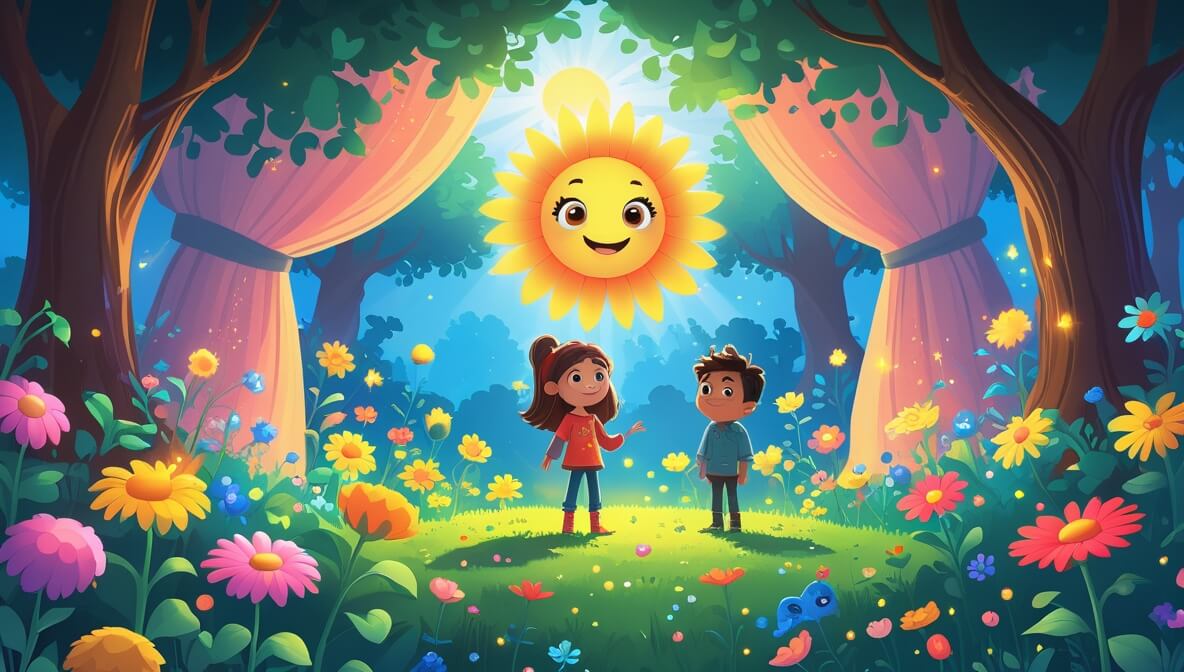In the heart of a magical forest, a mysterious garden holds the secret to talking flowers. Two curious children, Mia and Leo, embark on an adventure to uncover the truth about this enchanted place.
Age Recommendation
5 – 13 years
Characters
Characters:
- Mia: A curious and adventurous girl with a love for nature.
- Leo: Mia’s best friend, who enjoys solving mysteries and exploring.
- Petal: A wise and talkative flower from the enchanted garden.
Story
Mia and Leo wandered through the magical forest, their eyes sparkling with excitement. They had heard tales of a garden where flowers could talk, and they were determined to find it. The sun filtered through the leaves, casting playful shadows on the ground as they walked.
The Whispering Garden
As they ventured deeper, the trees parted like theater curtains, revealing a vibrant garden filled with flowers of every color. Mia halted, her eyes wide. “Leo, do you hear that?” she whispered.
Leo: (listening intently) I think… I think they’re whispering.
Mia: (grinning) Let’s get closer!
They tiptoed into the garden, trying not to disturb the peace. A gentle voice broke the silence, making them jump.
Petal: Welcome, young adventurers!
The children turned to see a large sunflower smiling at them, its petals glowing in the sunlight.
A Flower’s Tale
Mia: (in awe) You can talk!
Petal: Indeed, I can. This garden is special, and so are you for finding it.
Leo: (excitedly) How is it possible?
Petal: Magic, my dear. The forest shares its secrets with those who truly listen.
The children listened as Petal recounted tales of the forest’s history, the magic it held, and the importance of caring for nature.
Learning from Nature
Leo: (thoughtfully) We should tell others about this place so they can help protect it.
Mia: Yes, we must keep it safe!
Petal: That’s the spirit. Spread kindness and respect for the world around you.
With newfound determination, Mia and Leo promised to share the garden’s story and protect its magic.
The end.
Moral of the Story
Respect and protect nature, for it holds wonders beyond imagination. By sharing the beauty of the world and caring for it, we can preserve magical experiences for future generations.
Questions to Think About
- Why do you think the garden allowed Mia and Leo to hear the flowers?
- How can we help protect nature in our everyday lives?
- What would you do if you discovered a magical place like the garden?
- Why is it important to share stories about nature?
- What lessons did Mia and Leo learn from Petal?
Do You Know
- Some plants can communicate with each other through their roots or by releasing chemicals into the air.
- Flowers can tell us about the health of an ecosystem and play a crucial role in pollination.
Word Explorer
- Enchanted: Filled with magic or something extraordinary.
- Whispering: Speaking in a very soft or quiet voice.
- Determination: The quality of being determined to do something.
Emotions in the Story
- Excitement: When Mia and Leo first hear about the magical garden and set off on their adventure.
- Wonder: When they discover the talking flowers and hear Petal’s stories.
- Resolve: When they decide to protect the garden and share its magic with others.
Color Your Scene
Imagine Mia and Leo standing in the center of the garden, surrounded by flowers of every hue. The sun is shining brightly, casting golden rays on the petals. Draw this scene using colors like bright yellows, deep purples, vibrant reds, and lush greens.
Parents’ Corner
This story is a great way to talk to your child about:
Environmental awareness: Discuss the importance of taking care of nature and how we can make small changes to help the planet.
Curiosity and exploration: Encourage your child to explore the world around them and appreciate its beauty.
Sharing and storytelling: Highlight the significance of sharing stories that inspire others to care for the world.











